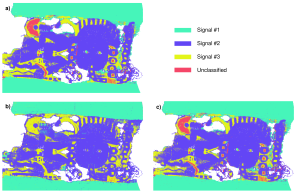
A practical workflow to capture and process hyperspectral images in combined VNIR-SWIR ranges is presented and discussed. The pipeline demonstration is intended to increase the visibility of the possibilities that advanced hyperspectral imaging techniques can bring to the study of archaeological textiles. Emphasis is placed on the fusion of data from two hyperspectral devices. Every aspect of the pipeline is analyzed, from the practical and optimal implementation of the imaging setup to the choices and decisions that can be made during the data processing steps. The workflow is demonstrated on an archaeological textile belonging to the Paracas Culture (Peru, 200 BC - 100 AD ca.) and displays an example in which an inappropriate selection of the processing steps can lead to a misinterpretation of the hyperspectral data.

Managing color on a particular imaging system is a wellunderstood challenge with a wealth of existing models, methods and techniques. In the case of printing systems, these tend to operate in the context of a single substrate, where managing color on every additional substrate is approach as a separate, detached problem. While such a mind-set works reasonably well in general, it breaks down when it comes to printing onto precolored textiles, such as pre-dyed fabrics. The present paper therefore introduces a family of approaches that support the use of multiple pre-colored textiles on a given printing system that also allow for a balance between characterization effort and color match accuracy. This, in turn provides solutions that can fit a variety of practical working patterns to maximize overall efficiency and performance.